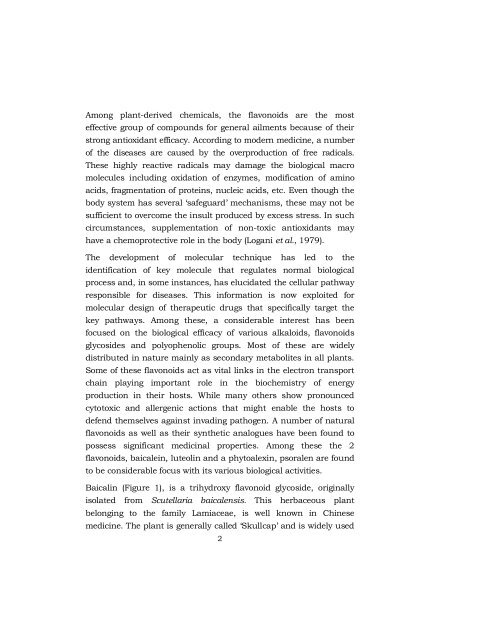Qualitative and quantitative analysis of biologically active principles ...
Qualitative and quantitative analysis of biologically active principles ...
Qualitative and quantitative analysis of biologically active principles ...
You also want an ePaper? Increase the reach of your titles
YUMPU automatically turns print PDFs into web optimized ePapers that Google loves.
Among plantderived chemicals, the flavonoids are the most<br />
effective group <strong>of</strong> compounds for general ailments because <strong>of</strong> their<br />
strong antioxidant efficacy. According to modern medicine, a number<br />
<strong>of</strong> the diseases are caused by the overproduction <strong>of</strong> free radicals.<br />
These highly re<strong>active</strong> radicals may damage the biological macro<br />
molecules including oxidation <strong>of</strong> enzymes, modification <strong>of</strong> amino<br />
acids, fragmentation <strong>of</strong> proteins, nucleic acids, etc. Even though the<br />
body system has several ‘safeguard’ mechanisms, these may not be<br />
sufficient to overcome the insult produced by excess stress. In such<br />
circumstances, supplementation <strong>of</strong> nontoxic antioxidants may<br />
have a chemoprotective role in the body (Logani et al., 1979).<br />
The development <strong>of</strong> molecular technique has led to the<br />
identification <strong>of</strong> key molecule that regulates normal biological<br />
process <strong>and</strong>, in some instances, has elucidated the cellular pathway<br />
responsible for diseases. This information is now exploited for<br />
molecular design <strong>of</strong> therapeutic drugs that specifically target the<br />
key pathways. Among these, a considerable interest has been<br />
focused on the biological efficacy <strong>of</strong> various alkaloids, flavonoids<br />
glycosides <strong>and</strong> polyophenolic groups. Most <strong>of</strong> these are widely<br />
distributed in nature mainly as secondary metabolites in all plants.<br />
Some <strong>of</strong> these flavonoids act as vital links in the electron transport<br />
chain playing important role in the biochemistry <strong>of</strong> energy<br />
production in their hosts. While many others show pronounced<br />
cytotoxic <strong>and</strong> allergenic actions that might enable the hosts to<br />
defend themselves against invading pathogen. A number <strong>of</strong> natural<br />
flavonoids as well as their synthetic analogues have been found to<br />
possess significant medicinal properties. Among these the 2<br />
flavonoids, baicalein, luteolin <strong>and</strong> a phytoalexin, psoralen are found<br />
to be considerable focus with its various biological activities.<br />
Baicalin (Figure 1), is a trihydroxy flavonoid glycoside, originally<br />
isolated from Scutellaria baicalensis. This herbaceous plant<br />
belonging to the family Lamiaceae, is well known in Chinese<br />
medicine. The plant is generally called ‘Skullcap’ <strong>and</strong> is widely used<br />
2

















